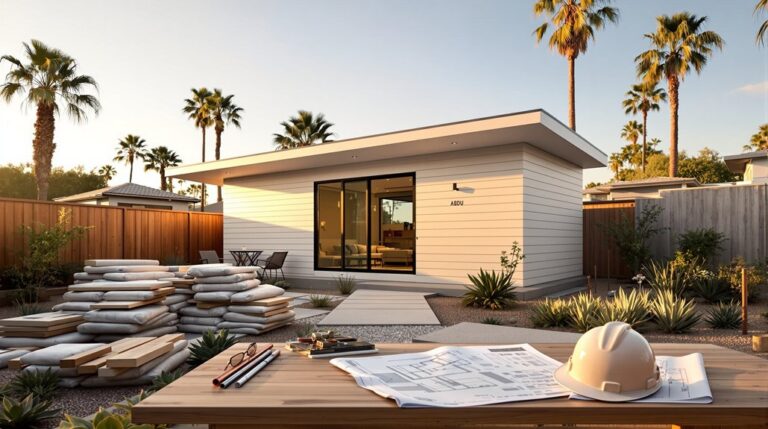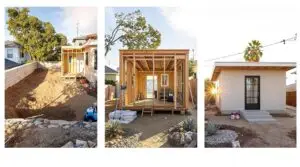You’ll spend between $80,000 and $480,000 on an ADU in San Diego County, depending on type and size. Conversion ADUs cost $80,000-$150,000, attached units run $120,000-$200,000, and detached structures range $150,000-$300,000. Construction averages $200-$400 per square foot, while permits add $15,000-$25,000. Don’t forget the 15-20% contingency budget for unexpected costs like utility connections and code compliance upgrades. Strategic planning and smart material choices can considerably reduce your total investment.
Key Takeaways
- Construction costs range $200-400 per square foot, with total project costs varying from $80,000-$480,000 depending on ADU type and size.
- Conversion ADUs ($80,000-$150,000) offer the most affordable option, while detached units ($150,000-$300,000) provide maximum privacy at higher costs.
- Permitting fees typically cost $15,000-$25,000, including building permits, impact fees, and utility connection charges throughout San Diego County.
- Budget an additional 15-20% contingency for unexpected costs like soil testing, utility upgrades, and structural modifications during construction.
- Reduce costs by choosing simple rectangular floor plans, mid-range finishes, and self-handling permits while planning utility connections strategically.
ADU Cost Breakdown: Construction, Permits, and Hidden Expenses

Three major cost categories will determine your ADU budget in San Diego County: construction expenses, permitting fees, and unexpected costs that often catch homeowners off guard.
Construction costs typically range from $200 to $400 per square foot, depending on materials, labor, and design complexity.
You’ll face permitting fees of $15,000-25,000, including plan checks, inspections, and impact fees.
Hidden expenses often emerge during construction: soil testing, utility connections, fire safety upgrades, and parking modifications.
Site preparation costs vary dramatically based on your property’s conditions.
Budget an additional 15-20% contingency for unforeseen issues like structural modifications or code compliance requirements.
Detached vs. Attached vs. Conversion ADUs: Price Comparisons
When choosing between ADU types, you’ll find significant price differences that directly impact your project’s feasibility and return on investment.
1. Conversion ADUs ($80,000-$150,000) – Converting existing garages, basements, or other structures costs the least since you’re working with established foundations, walls, and roofing.
You’ll mainly pay for interior work, plumbing, electrical upgrades, and permits.
2. Attached ADUs ($120,000-$200,000) – Building additions onto your main house costs more than conversions but less than detached units.
You’ll share some utilities and structural elements, reducing overall expenses.
3. Detached ADUs ($150,000-$300,000) – New standalone structures require complete construction from foundation to roof, making them most expensive but offering maximum privacy and rental potential.
Size and Square Footage Impact on Total Project Costs

Square footage directly determines your ADU’s construction costs, with prices typically ranging from $200 to $400 per square foot depending on finishes and complexity.
You’ll pay approximately $60,000 to $120,000 for a 300-square-foot studio, while a 1,200-square-foot two-bedroom unit costs $240,000 to $480,000.
Smaller ADUs often cost more per square foot due to fixed expenses like permits, utility connections, and kitchen installations that don’t scale proportionally.
You can optimize costs by choosing efficient layouts that maximize livable space without unnecessary square footage.
Consider multi-functional designs and innovative storage solutions to reduce overall size while maintaining functionality.
San Diego County Permit Fees and Regulatory Requirements
Before you can break ground on your ADU project, you’ll need to navigate San Diego County’s permit requirements, which typically cost between $15,000 and $25,000 for most projects.
These fees vary based on your ADU’s size, complexity, and specific location within the county.
Your permit costs will include:
- Building permits – Base fees plus plan review charges that range from $8,000 to $15,000
- Impact fees – Development and school district fees averaging $3,000 to $8,000
- Utility connection fees – Water, sewer, and electrical hookups costing $2,000 to $5,000
You’ll also need approved architectural plans meeting California’s ADU regulations before submitting applications.
Design Complexity: How Finishes and Features Affect Your Budget

Beyond securing permits and approvals, your ADU’s final cost hinges mainly on the design choices you make throughout construction.
Basic finishes like laminate countertops and vinyl flooring keep costs around $150-200 per square foot. Mid-range selections, including quartz counters and hardwood floors, push expenses to $200-300 per square foot. Premium finishes like marble, custom cabinetry, and high-end appliances can exceed $350 per square foot.
Complex features such as vaulted ceilings, multiple bathrooms, or smart home systems add $10,000-50,000 to your budget. You’ll save considerably by choosing simpler layouts and standard finish packages over luxury upgrades.
Utility Connections and Site Preparation Expenses
Three significant utility connections will considerably impact your ADU budget: electrical, plumbing, and gas lines.
You’ll face varying costs depending on your primary home’s proximity to the ADU location and existing infrastructure capacity.
Site preparation expenses include:
- Electrical service upgrades – $2,000-$8,000 for panel upgrades and new circuits to handle ADU power demands
- Plumbing connections – $3,000-$12,000 for sewer line extensions, water service lines, and potential main line upgrades
- Gas line installation – $1,500-$4,000 for natural gas connections to power appliances and heating systems
The distance from your main house directly affects trenching and connection costs.
Financing Options for ADU Projects in San Diego County

Since ADU construction costs in San Diego County typically range from $150,000 to $400,000, you’ll need substantial financing to turn your project into reality.
Home equity loans offer competitive rates since you’re borrowing against your property’s value. Cash-out refinancing lets you tap into accumulated equity while potentially securing lower interest rates.
Personal loans provide quick approval but carry higher rates for smaller projects. Some contractors offer financing programs with flexible terms.
Credit unions often provide better rates than traditional banks. Consider combining multiple funding sources to optimize your financing structure and reduce overall borrowing costs for your ADU investment.
Cost-Cutting Strategies That Won’t Compromise Quality
While ADU construction requires significant investment, strategic planning can substantially reduce costs without sacrificing build quality or long-term value.
1. Choose simple, rectangular floor plans**** – Complex shapes with multiple angles increase framing costs and material waste.
Stick to basic geometries that maximize square footage while minimizing construction complexity.
2. Select mid-range finishes strategically – You don’t need luxury materials everywhere.
Invest in quality flooring and fixtures in high-traffic areas, then use cost-effective alternatives in utility spaces and bedrooms.
3. Handle permitting yourself – Research San Diego County’s ADU requirements and submit applications directly rather than paying consultants thousands in fees for straightforward projects.
Return on Investment: Rental Income Potential and Property Value Increase

Building an ADU transforms from a significant expense into a wealth-building investment when you consider both immediate rental income and long-term property appreciation.
In San Diego County, ADUs typically rent for $1,800-$3,500 monthly, depending on size and location. You’ll recover your initial investment in 8-12 years through rental income alone.
Beyond cash flow, ADUs add 20-30% to your property’s market value. If you’ve spent $200,000 on construction, expect $250,000-$300,000 in added home equity.
This dual benefit—monthly income plus appreciation—makes ADUs one of San Diego’s most substantial real estate investments, especially given the county’s persistent housing shortage and rental demand.
Frequently Asked Questions
How Long Does It Take to Build an ADU in San Diego County?
Building an ADU in San Diego County typically takes 6-12 months from start to finish.
You’ll spend 2-4 months on permits and approvals, which can be the most extended phase.
Once construction begins, you’re looking at 3-6 months depending on your ADU’s size and complexity.
Weather delays, material availability, and contractor scheduling can extend timelines.
If you’re doing a conversion rather than new construction, you’ll likely finish faster than building from scratch.
Do I Need to Hire an Architect for My ADU Project?
You don’t always need to hire an architect for your ADU project.
If you’re building a simple, small ADU under 750 square feet, you might use pre-approved plans or work with a design-build contractor who handles both design and construction.
However, for complex designs, unique sites, or larger ADUs, you’ll want an architect to guarantee proper planning, code compliance, and maximize your space efficiently.
Can I Live in My ADU While Renting Out My Main House?
You can live in your ADU while renting out your main house!
This strategy is becoming increasingly popular as it allows you to generate rental income from your larger property while maintaining your homeownership.
You’ll need to guarantee your ADU meets all habitability requirements and local zoning regulations.
Consider factors like privacy, parking access, and utilities when making this arrangement.
It’s a smart way to maximize your property’s financial potential.
What Insurance Changes Are Needed When Adding an ADU to My Property?
You’ll need to contact your insurance company to update your homeowner’s policy when adding an ADU.
Most insurers require coverage adjustments for the additional structure, increased dwelling coverage limits, and potential liability exposure.
If you’re renting out either unit, you’ll likely need landlord or rental property insurance.
Don’t assume your current policy automatically covers the ADU – get written confirmation of what’s covered before tenants move in.
Are There Tax Implications for Building an ADU in San Diego?
Yes, you’ll face several tax implications when building an ADU in San Diego.
Your property taxes will increase based on the ADU’s assessed value, typically adding $3,000-$8,000 annually. If you rent it out, you’ll pay income tax on rental revenue.
However, you can deduct construction costs, depreciation, maintenance, and utilities. You might also qualify for tax credits if you use energy-efficient materials or systems during construction.



